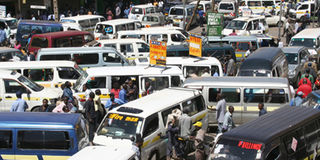Ban private cars not matatus, urge passengers

Traffic congestion along Nairobi's Accra road. Chaos marked the implementation of City Hall rules restricting long-distance public service vehicles from entering Nairobi’s central business district. PHOTO/MICHAEL MUTE
What you need to know:
- Nairobi congestion problem could be solved if motorists use PSVs, experts say
Chaos marked the implementation of City Hall rules restricting long-distance public service vehicles from entering Nairobi’s central business district.
As of August 24, matatus from Kisii and Bomet were required to drop passengers off at the Westlands bus park while those from Thika were to drop off and pick up their passengers at Kariokor.
Insensitive
Spot checks indicated that few matatus complied as most operators and passengers complained that the new rules were unfair.
Experts and lobby groups are suggesting that if city council wants to ease traffic congestion in Nairobi’s central business district, then private vehicles should be discouraged entering the area.
According to Prof Sixtus Kinyua Mwea, the chairman of the Kenya Urban Roads Authority, the average peak hour speed of vehicles within the city’s boundaries would slow to under 10 km/h by 2012 if nothing is done to deal with the congestion.
He said vehicles now travel at less than 20 km/h, while the city’s major roads support an average of 70,000 vehicles a day. Most of these, he said, are private vehicles carrying one person to and from work.
Prof Mwea suggests something be done to encourage motorists to leave their cars home and take a public service vehicle to work.
“It is pointless for me to drive my vehicle into the city centre every day to congest the parking space and the road,” he said at his office at the University of Nairobi where he is also the chairman of the Department of Civil Engineering.
Mass transport
Prof Mwea said the construction of car parks for private vehicles outside the city and the provision of mass transport vehicles into the city centre could be the answer to the congestion problem.
He said the introduction of efficient buses manned by professional crews could go a long way towards convincing people to leave their cars outside the city centre.
A team set up under then Transport minister John Michuki at the start of the implementation of the Michuki Rules in 2004 also recommended this plan of action.
If the Integrated National Transport Policy is implemented, City Hall could be forced to radically change its approach to traffic management and how it handles private motorists.
The policy was adopted by the Cabinet two weeks ago, and it is understood that the Transport ministry has prepared a sessional paper to be debated by Parliament.
The policy proposes phasing out 14-seater matatus in five years while offering co-operative societies, banks and local investors incentives to invest in larger vehicles able to carry at least 50 passengers.
Special bus lanes would be established in Nairobi and Mombasa to allow for faster movement to reduce travelling time.
“To reduce congestion through urban traffic zoning control, all matatus in urban areas will be outlawed from the central business districts. In major urban areas, road transport routes leading to the CBDs will be designated by corridors,” the policy paper says.
In Nairobi, the corridors are defined as Jogoo, Juja, Thika, Mombasa, Lang’ata and Limuru roads as well as Waiyaki Way. These are the city’s main arteries and the main entry points for the millions of people who troop into Nairobi daily.
The policy says matatu terminuses will be built off the major corridors and from them buses would transport passengers into the city centre.
Park and Ride
In transport jargon, the concept is known as Park and Ride . It basically means the motorist drives to a designated secure parking lot, leaves his car and then catches a bus into the CBD.
One such designated parking lot was recently opened at the former Belle Vue Cinema at the turnoff to South C on Mombasa Road in a move that was then hailed as a “cure” to the constant traffic snarl-ups on Mombasa Road.
But nothing has changed, and the plan appears to have flopped, ostensibly because motorists continue to prefer spending hours in traffic jams in their own vehicles rather than use the often overcrowded and dangerously unsafe public service vehicles.
Nairobi could also follow the lead of London and create a special “Congestion Zone” in the CBD and charge motorists to access it.
Authorities in the English city discourage motorists from entering the clearly defined zone of central London during the day from Monday to Friday unless they pay a Sh1,000 congestion charge.
But London traffic controllers admit that although the charge was initially a deterrent, the number of cars entering the congestion zone has gone back up to the levels recorded before the before the charge was introduced.




